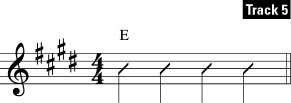Strumming means dragging a pick (or the fingers) across the strings of the guitar. You drag the guitar pick in a downward motion (toward the floor) to sound the chords formed by the left hand, but you don't try to do anything except sound the chords. In doing even that, however, you create rhythm.
If you "pick-drag" in regular, even strokes, one per beat, adhering to a tempo (musical rate), you're strumming the guitar in rhythm. And that's music, whether you mean it to be or not. More specifically, you're strumming a quarter-note rhythm, which is fine for songs such as the Beatles' "Let It Be," and other ballads. For the record, strumming an E chord in quarter notes looks like the notation in Figure 1. Note that rhythm slashes are used to show that you should play the entire chord, as opposed to note heads (which indicate only a single pitch).
>

>
Figure 1: Playing an E chord in one bar of four quarter notes.
The hardest part of learning rhythm guitar is realizing — and then maintaining — all the repetition involved. It's not what people expect when they pick up the guitar and want to learn a smorgasbord of cool licks and great riffs. But being able to play in time with unerring precision and rock-steady consistency is an essential skill and a hallmark of solid musicianship. Most rhythm playing in rock guitar involves a one- or two-bar pattern that gets repeated over and over, varying only where there are accent points that the band plays in unison.
After you learn to play consistently, you can then deviate from the established pattern you lay down and work on your own variations, as long as they're tasteful, appropriate, and not too numerous. Like a rock and roll rebel once said, "You have to know the rules before you can break them."
Downstrokes
A downstroke is the motion of dragging the pick toward the floor in a downward motion, brushing across multiple strings on the guitar in the process. Because you execute a downstroke quickly (even on slow songs) the separate strings are sounded virtually simultaneously. If you play three or more notes this way, you produce a chord.
Strumming in eighth-note downstrokes
To get out of the somewhat plodding rhythm of a quarter-note-only strumming pattern, you turn to eighth notes. As the math implies, an eighth note is one half the value of a quarter note, but in musical terms that equates to twice as fast, or more precisely, twice as frequently.
So instead of playing one strum per beat, you now play two strums per beat. This means you must move your hand twice as fast, striking the strings two times per beat, instead of once per beat as you did to produce quarter notes. At moderate and slower tempos, you can do this easily. For faster tempos you use alternating upstrokes and downstrokes. For playing the progression in Figure 1, however, simply using repeated downstrokes is easiest.
Figure 2 uses eighth notes for the first three beats of each bar and a quarter note for the last beat of each bar. The quarter note allows you a little more time to switch chords between the end of each bar and the beginning of the new bar. Isn't that humane?
>

>
Figure 2: An eighth-note progression using right-hand downstrokes.
The term sim. in the music notation tells you to continue in a similar fashion. It's typically used for articulation directions, such as down- and upstrokes.
Reading eighth-note notation
Notice that instead of the previously used slashes, you now resort to slashes with stems (the vertical lines coming down from the note head) and beams (the thicker horizontal lines that connect the stems). Quarter notes have single stems attached to them; eighth notes have stems with beams connecting them to each other. An eighth note by itself, or separated by a rest, will have a flag instead of a beam
Upstrokes
An upstroke is just what it sounds like: the opposite of a downstroke. Instead of dragging your pick down toward the floor, as you would in a downstroke, you start from a position below the strings and drag your pick upward across the strings. Doing this comfortably may seem a little less natural than playing a downstroke. One reason for this is that you're going against gravity. Also, some beginners have a hard time holding on to their pick or preventing it from getting stuck in the strings. With practice, however, you can flow with the ups as easily as you can with the downs.
You use upstrokes for the upbeats (offbeats) in eighth-note playing as the strokes in between the quarter-note beats.
When you start playing, don't worry about hitting all the strings in an upstroke. For example, when playing an E chord with an upstroke, you needn't strum the strings all the way through to the sixth string. Generally, in an upstroke, hitting just the top three or four strings is good enough. You may notice that your right hand naturally arcs away from the strings by that point, to an area above the center of the guitar. This is fine.
Upstrokes do not get equal time with their downwardly mobile counterparts. You typically use upstrokes only in conjunction with downstrokes. Whereas you can use downstrokes by themselves just fine — for entire songs, even — very rarely do you use upstrokes in isolation or without surrounding them on either side with downstrokes.
So you should first tackle upstrokes in their most natural habitat: in an eighth-note rhythm figure where they provide the in-between notes, or offbeats, to the on-the-beat downstrokes.
>
dummies
Source:http://www.dummies.com/how-to/content/guitar-basics-strumming-an-electric-guitar.html
No comments:
Post a Comment